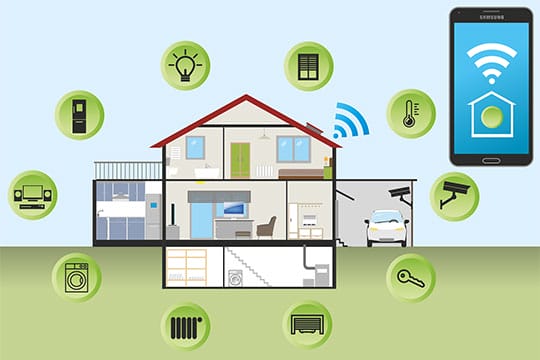Several smart technologies, though in the starting phase of their development, create a futuristic feel to homes. Nowadays, the home automation market is evolving rapidly; a significant portion of this growth is enhancing via the tablet market. Smart home DIYers are making good use of their tablets, converting it into a remote control. The smart home will continue to evolve as long as people can come to realize that smart homes are an investment into the future. With the increase in growth of the smart home market, more users can enjoy potential savings.
Today, many of us are familiar with the smart home basics due to the advent of the Internet of Things (IoT) into many homes. The Smart Home is defined as a home system that is completely automated and the appliances that can be controlled via a WiFi connection remotely. This highly sophisticated system enables the homeowner to detect and govern the home’s functions. In the market, there are many products that can be installed in an ordinary home, allowing a particular function to operate as a smart system. Fully automated smart homes consist of a major automated control hub that governs all the other systems in the house. Smart homes are very sustainable and can create a sense of security and comfort. Electronic devices, heating, and lightning are just a few instances of what can be governed remotely by a computer or a smartphone.
The Smart Home Development
Smart home technology and devices are evolving rapidly along with computer sensors and controls. Drivers that are linking all the distinct devices are developed to make sure the compatibility exists between different devices. Whichever technology, smart homes are creating new opportunities in our day-to-day life.

The world will have about 50 billion internet-connected devices by 2020. We can already witness the development of care facilities, connected factories, smart cities, and our homes connected to the IoT. With further advancements, we can accept the fact that connectivity problems will disappear, applications will increase, and certain things would become less costly.
Recommended for you: Smart Products for Your Home on a Pocket-Friendly Budget.
The Market Size and Market Drivers of Smart Homes
Strategy Analytics research forecasts that the smart home market will grow up to $62 billion by the end of 2020. North America holds the largest smart home market share.
The capability to handle home energy is one of the largest market drivers of smart homes around the world. Security devices are among the major market drivers of smart homes. It is estimated that over 709 million security devices would be shipped in 2019.
Advantages of Smart Homes

Self-sufficient
 Using water harvesting systems and wind power or solar power can help one become more self-reliant. Even gardens use smart technology allowing you to make the maximum use of your garden and money and time involved in going to the market and buying.
Using water harvesting systems and wind power or solar power can help one become more self-reliant. Even gardens use smart technology allowing you to make the maximum use of your garden and money and time involved in going to the market and buying.
Cost-effective
 Smart technology might seem intimidating for most of the people have this misconception that the systems and appliances are too expensive for them. Smart appliances might be costly but they save more on energy in the long run. This turns out to be less expensive in an indirect way. Thermostat control can save up to 30 percent on the energy bill. Less waste emanates all over the home that also allows you to save on water and energy. Smart homes enhance your home’s resale value with every extra piece of smart technology added to it. So, they are considered to be great investments.
Smart technology might seem intimidating for most of the people have this misconception that the systems and appliances are too expensive for them. Smart appliances might be costly but they save more on energy in the long run. This turns out to be less expensive in an indirect way. Thermostat control can save up to 30 percent on the energy bill. Less waste emanates all over the home that also allows you to save on water and energy. Smart homes enhance your home’s resale value with every extra piece of smart technology added to it. So, they are considered to be great investments.
Energy efficiency
 Smart home technology is designed specially to be green, enabling appliances to utilize a small amount of energy. Sensor detectors, cooking systems, and intelligent heating systems allow very less waste. Stove tops will burn by itself only when the pan is detected and handling the correct boil can be automated, thereby saving a large amount of energy. Shower faucets, for instance, can provide a full shower experience while utilizing minimum water.
Smart home technology is designed specially to be green, enabling appliances to utilize a small amount of energy. Sensor detectors, cooking systems, and intelligent heating systems allow very less waste. Stove tops will burn by itself only when the pan is detected and handling the correct boil can be automated, thereby saving a large amount of energy. Shower faucets, for instance, can provide a full shower experience while utilizing minimum water.
Control
 Smart appliances enable you to govern those specific appliances by using an app on your mobile device irrespective of your location. Nest learning thermostat is an example of these appliances. This will enable you to work with it from a distance.
Smart appliances enable you to govern those specific appliances by using an app on your mobile device irrespective of your location. Nest learning thermostat is an example of these appliances. This will enable you to work with it from a distance.
Quality of Life
 People with disabilities or the elderly children can gain advantage from smart technology because the smart homes can operate on voice commands and are very easy to use. Switching off water taps or lights automatically when they are not in use ensures decreased waste. In order to make an everyday task easier, automated systems can be personalized according to the individual. Smart technology helps in making the task of keeping the home in order, much easier for you as automated cleaning can be organized, thus providing additional time for yourself and less stress.
People with disabilities or the elderly children can gain advantage from smart technology because the smart homes can operate on voice commands and are very easy to use. Switching off water taps or lights automatically when they are not in use ensures decreased waste. In order to make an everyday task easier, automated systems can be personalized according to the individual. Smart technology helps in making the task of keeping the home in order, much easier for you as automated cleaning can be organized, thus providing additional time for yourself and less stress.
You may also like: The Xiaomi Mi Robot Vacuum Cleaner – A Comprehensive Feature Review.
No limitations
 Apps are devised for almost any feature in your homes such as refilling the food dish of your pet, door opening, water, lighting, and home stereos. You can even order the monthly grocery items through apps.
Apps are devised for almost any feature in your homes such as refilling the food dish of your pet, door opening, water, lighting, and home stereos. You can even order the monthly grocery items through apps.
The Future of Smart Homes

The IoT will not only save money for us but also make our lives comfortable. As I said earlier, North America is the largest user of smart homes at present but in the next few years, the Asia Pacific region might overhaul North America. This is due to the increasing demand for connected devices in Japan, India, and China. Europe is considered as the second most significant market for smart homes with the major focus being comfort and energy savings.
This article is written by Savaram Ravindra. He was born and raised in Hyderabad, popularly known as the ‘City of Pearls’. He is presently working as a Content Contributor at Mindmajix.com. Connect with him on LinkedIn and Twitter.






